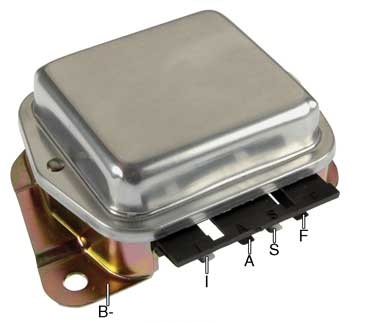PT 1:
I recently got a Balmar 812-65 from Fleabay for cheap new in box I'll have some details on installing it shortly, but here is the summary:
I'll have some details on installing it shortly, but here is the summary:
This alternator was sold by Balmar with their trademark white and blue paint, but inside it is based on a Prestolite 65 amp alternator. Prestolite is related to Motorola and Leece-Neville, so this looks a lot like our stock 37 and 50 amp Motorolas.
I will follow up with some photos detailing what needs doing to install it, but to cut to the chase, here are the results: It seems to do better than any of my other alternators at low speeds. I saw 27 amps just off idle - maybe 1200-1400 RPM or so. Neither my Motorolas nor 120 amp 10si will do this. At full speed cruise, say 2300 RPM +/-, I loaded the system up with a hair dryer and saw 55 amps out This is obviously vastly better than the 37 amp Motorola. My 50 amp Motorola might maybe hit 40 amps on a good day and the 10si maybe 47 or so, maybe 50 briefly.
This is obviously vastly better than the 37 amp Motorola. My 50 amp Motorola might maybe hit 40 amps on a good day and the 10si maybe 47 or so, maybe 50 briefly.
I recently got a Balmar 812-65 from Fleabay for cheap new in box
 I'll have some details on installing it shortly, but here is the summary:
I'll have some details on installing it shortly, but here is the summary:This alternator was sold by Balmar with their trademark white and blue paint, but inside it is based on a Prestolite 65 amp alternator. Prestolite is related to Motorola and Leece-Neville, so this looks a lot like our stock 37 and 50 amp Motorolas.
I will follow up with some photos detailing what needs doing to install it, but to cut to the chase, here are the results: It seems to do better than any of my other alternators at low speeds. I saw 27 amps just off idle - maybe 1200-1400 RPM or so. Neither my Motorolas nor 120 amp 10si will do this. At full speed cruise, say 2300 RPM +/-, I loaded the system up with a hair dryer and saw 55 amps out
 This is obviously vastly better than the 37 amp Motorola. My 50 amp Motorola might maybe hit 40 amps on a good day and the 10si maybe 47 or so, maybe 50 briefly.
This is obviously vastly better than the 37 amp Motorola. My 50 amp Motorola might maybe hit 40 amps on a good day and the 10si maybe 47 or so, maybe 50 briefly.







Comment